Human Resource Management: Generational Diversity Report Analysis
VerifiedAdded on 2022/09/12
|6
|1146
|10
Report
AI Summary
This report delves into the critical topic of generational diversity within Human Resource Management. It begins by defining diversity and generational diversity, highlighting its significance in today's competitive business environment. The report explores the characteristics of different generations in the workforce, including the Silent Generation, Baby Boomers, Generation X, and Millennials, emphasizing their unique values and perspectives. It discusses the advantages of generational diversity, such as improved problem-solving, innovation, and mentoring opportunities. The report also acknowledges potential challenges, including difficulties in recruitment and differing working styles. Furthermore, the report outlines strategies for enhancing generational diversity, such as adapting to changing trends, offering coaching, and establishing multi-generational teams. The conclusion emphasizes the importance of building synergies between different generational groups to foster open communication and adapt leadership styles to meet the needs of each employee. The report concludes that promoting generational diversity is crucial for organizational success.
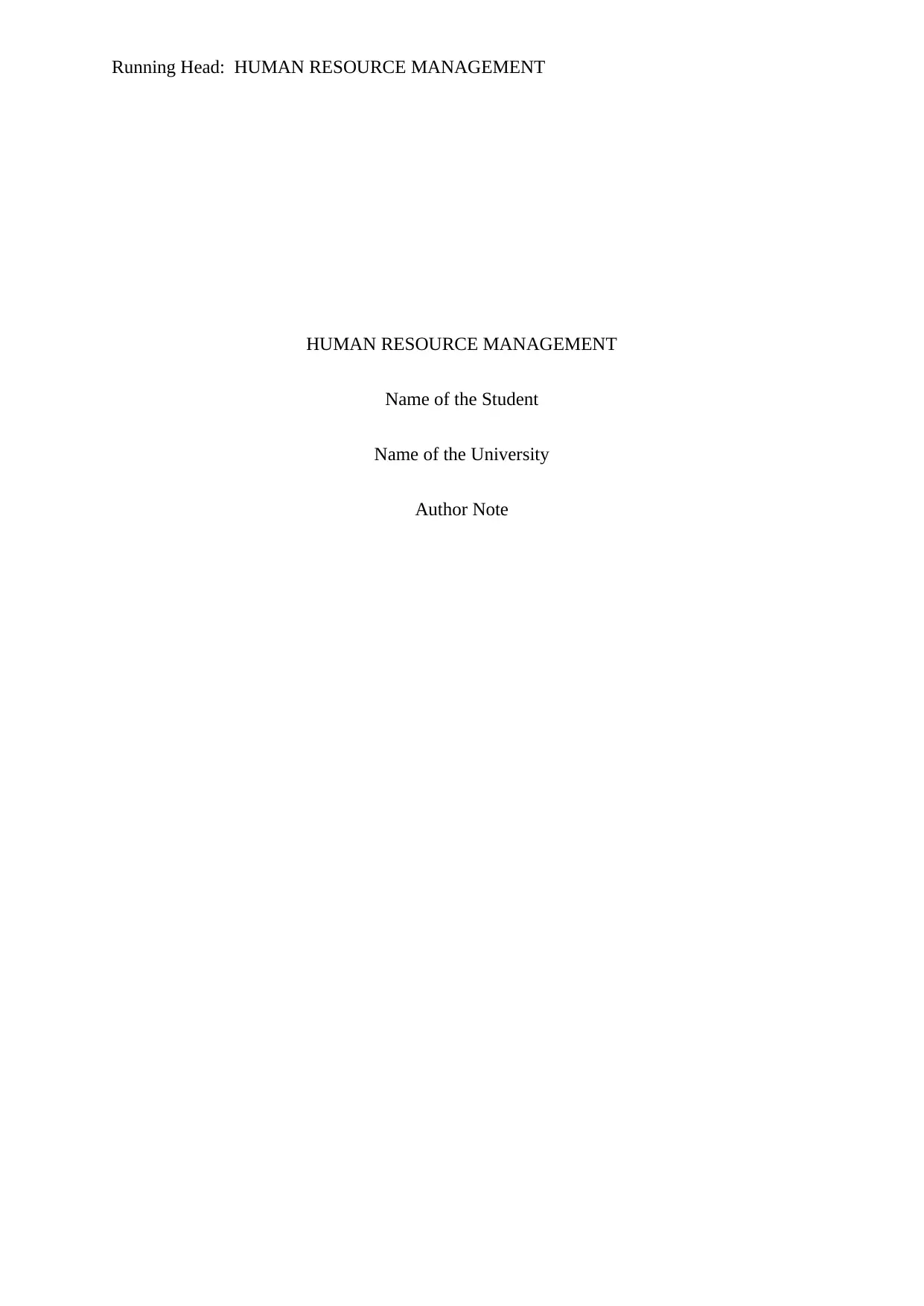
Running Head: HUMAN RESOURCE MANAGEMENT
HUMAN RESOURCE MANAGEMENT
Name of the Student
Name of the University
Author Note
HUMAN RESOURCE MANAGEMENT
Name of the Student
Name of the University
Author Note
Paraphrase This Document
Need a fresh take? Get an instant paraphrase of this document with our AI Paraphraser
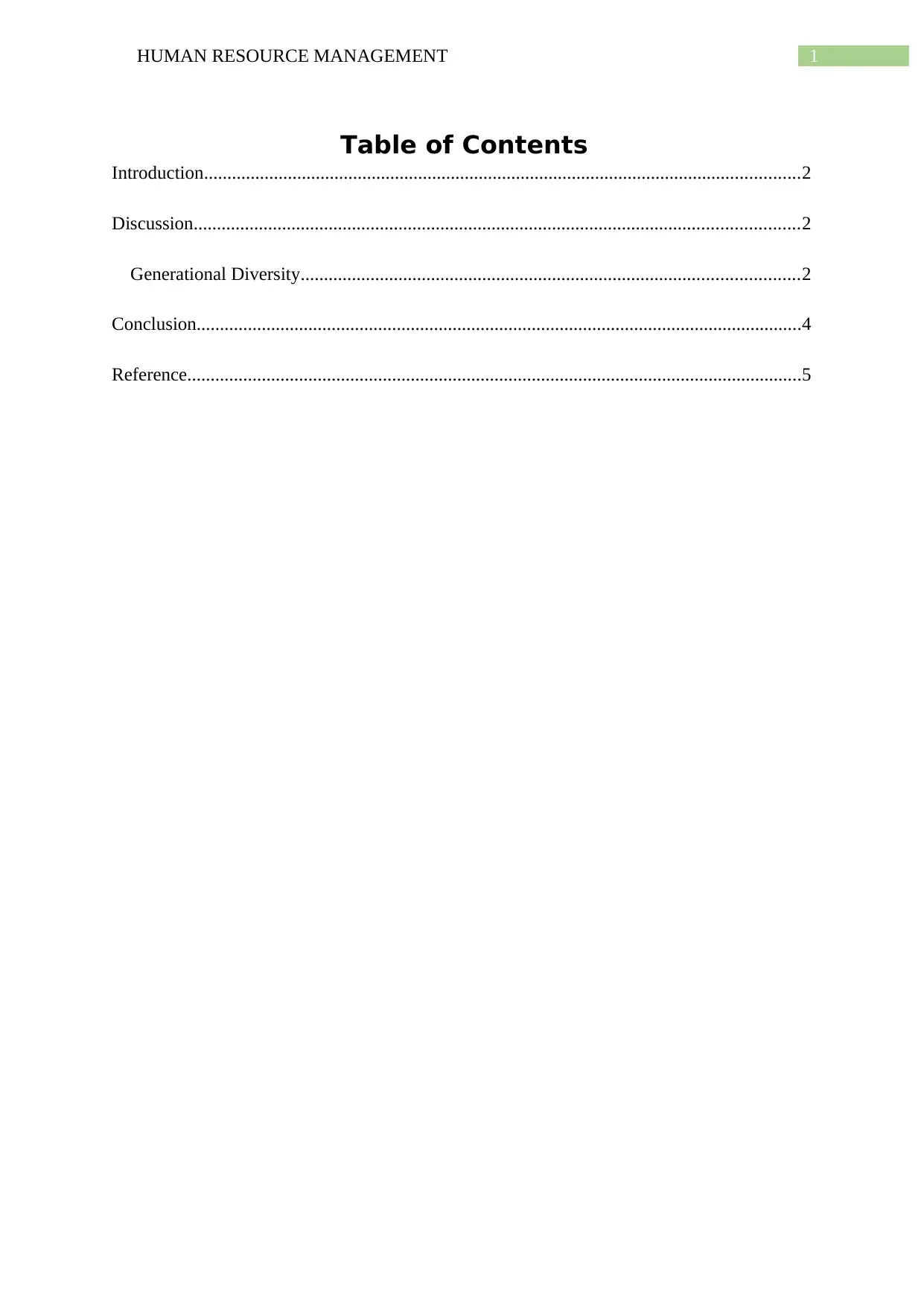
1HUMAN RESOURCE MANAGEMENT
Table of Contents
Introduction................................................................................................................................2
Discussion..................................................................................................................................2
Generational Diversity...........................................................................................................2
Conclusion..................................................................................................................................4
Reference....................................................................................................................................5
Table of Contents
Introduction................................................................................................................................2
Discussion..................................................................................................................................2
Generational Diversity...........................................................................................................2
Conclusion..................................................................................................................................4
Reference....................................................................................................................................5
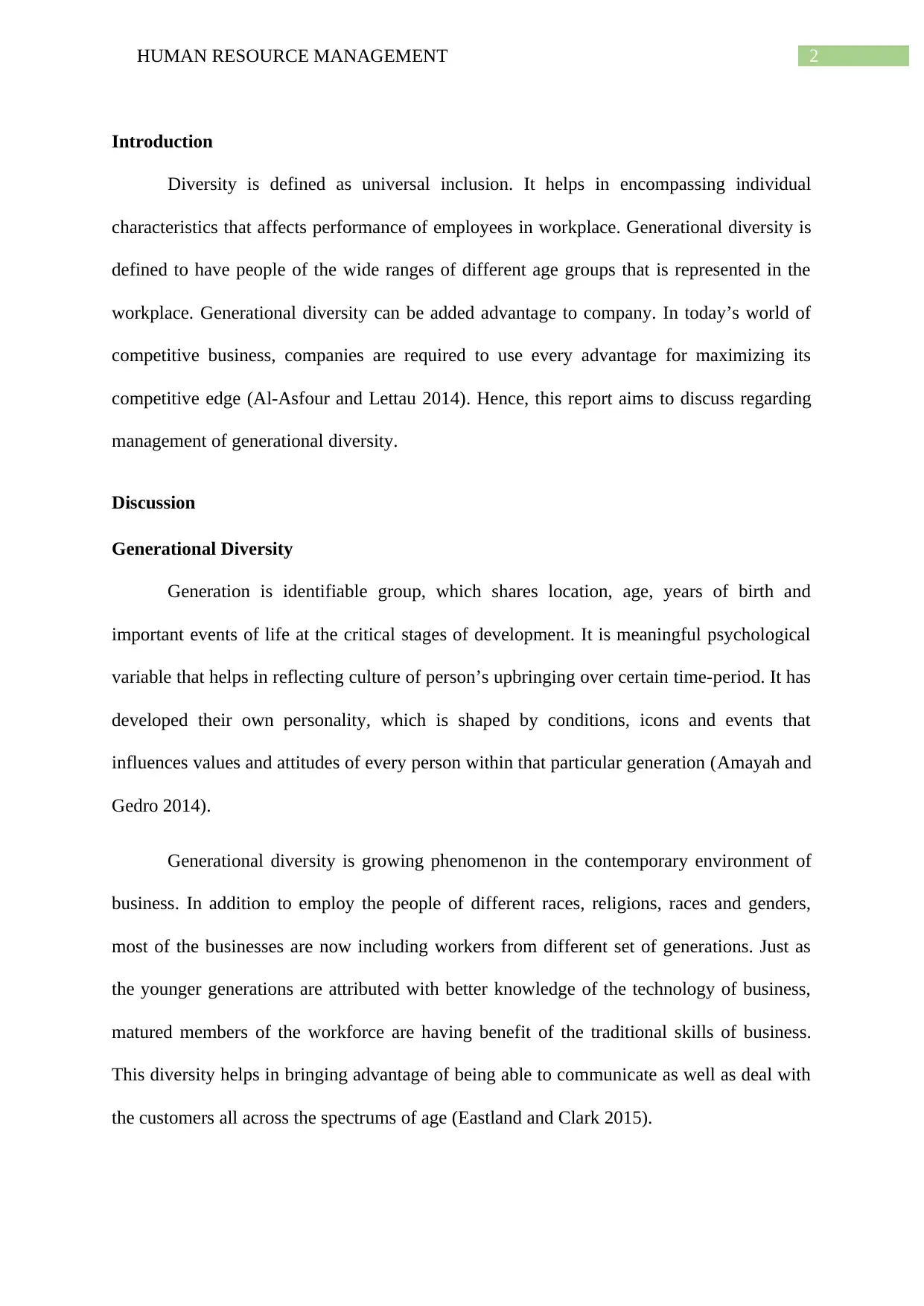
2HUMAN RESOURCE MANAGEMENT
Introduction
Diversity is defined as universal inclusion. It helps in encompassing individual
characteristics that affects performance of employees in workplace. Generational diversity is
defined to have people of the wide ranges of different age groups that is represented in the
workplace. Generational diversity can be added advantage to company. In today’s world of
competitive business, companies are required to use every advantage for maximizing its
competitive edge (Al-Asfour and Lettau 2014). Hence, this report aims to discuss regarding
management of generational diversity.
Discussion
Generational Diversity
Generation is identifiable group, which shares location, age, years of birth and
important events of life at the critical stages of development. It is meaningful psychological
variable that helps in reflecting culture of person’s upbringing over certain time-period. It has
developed their own personality, which is shaped by conditions, icons and events that
influences values and attitudes of every person within that particular generation (Amayah and
Gedro 2014).
Generational diversity is growing phenomenon in the contemporary environment of
business. In addition to employ the people of different races, religions, races and genders,
most of the businesses are now including workers from different set of generations. Just as
the younger generations are attributed with better knowledge of the technology of business,
matured members of the workforce are having benefit of the traditional skills of business.
This diversity helps in bringing advantage of being able to communicate as well as deal with
the customers all across the spectrums of age (Eastland and Clark 2015).
Introduction
Diversity is defined as universal inclusion. It helps in encompassing individual
characteristics that affects performance of employees in workplace. Generational diversity is
defined to have people of the wide ranges of different age groups that is represented in the
workplace. Generational diversity can be added advantage to company. In today’s world of
competitive business, companies are required to use every advantage for maximizing its
competitive edge (Al-Asfour and Lettau 2014). Hence, this report aims to discuss regarding
management of generational diversity.
Discussion
Generational Diversity
Generation is identifiable group, which shares location, age, years of birth and
important events of life at the critical stages of development. It is meaningful psychological
variable that helps in reflecting culture of person’s upbringing over certain time-period. It has
developed their own personality, which is shaped by conditions, icons and events that
influences values and attitudes of every person within that particular generation (Amayah and
Gedro 2014).
Generational diversity is growing phenomenon in the contemporary environment of
business. In addition to employ the people of different races, religions, races and genders,
most of the businesses are now including workers from different set of generations. Just as
the younger generations are attributed with better knowledge of the technology of business,
matured members of the workforce are having benefit of the traditional skills of business.
This diversity helps in bringing advantage of being able to communicate as well as deal with
the customers all across the spectrums of age (Eastland and Clark 2015).
⊘ This is a preview!⊘
Do you want full access?
Subscribe today to unlock all pages.

Trusted by 1+ million students worldwide
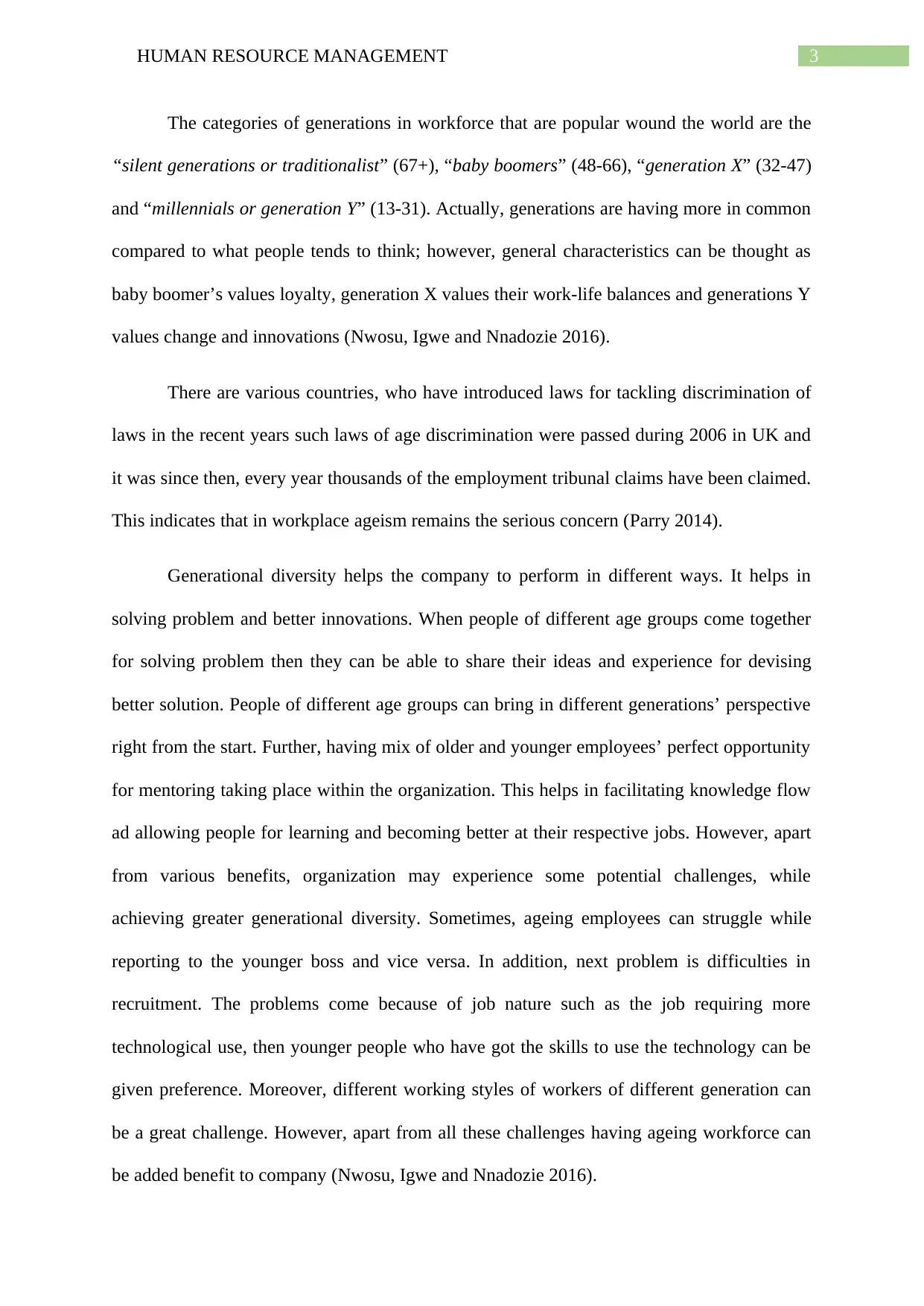
3HUMAN RESOURCE MANAGEMENT
The categories of generations in workforce that are popular wound the world are the
“silent generations or traditionalist” (67+), “baby boomers” (48-66), “generation X” (32-47)
and “millennials or generation Y” (13-31). Actually, generations are having more in common
compared to what people tends to think; however, general characteristics can be thought as
baby boomer’s values loyalty, generation X values their work-life balances and generations Y
values change and innovations (Nwosu, Igwe and Nnadozie 2016).
There are various countries, who have introduced laws for tackling discrimination of
laws in the recent years such laws of age discrimination were passed during 2006 in UK and
it was since then, every year thousands of the employment tribunal claims have been claimed.
This indicates that in workplace ageism remains the serious concern (Parry 2014).
Generational diversity helps the company to perform in different ways. It helps in
solving problem and better innovations. When people of different age groups come together
for solving problem then they can be able to share their ideas and experience for devising
better solution. People of different age groups can bring in different generations’ perspective
right from the start. Further, having mix of older and younger employees’ perfect opportunity
for mentoring taking place within the organization. This helps in facilitating knowledge flow
ad allowing people for learning and becoming better at their respective jobs. However, apart
from various benefits, organization may experience some potential challenges, while
achieving greater generational diversity. Sometimes, ageing employees can struggle while
reporting to the younger boss and vice versa. In addition, next problem is difficulties in
recruitment. The problems come because of job nature such as the job requiring more
technological use, then younger people who have got the skills to use the technology can be
given preference. Moreover, different working styles of workers of different generation can
be a great challenge. However, apart from all these challenges having ageing workforce can
be added benefit to company (Nwosu, Igwe and Nnadozie 2016).
The categories of generations in workforce that are popular wound the world are the
“silent generations or traditionalist” (67+), “baby boomers” (48-66), “generation X” (32-47)
and “millennials or generation Y” (13-31). Actually, generations are having more in common
compared to what people tends to think; however, general characteristics can be thought as
baby boomer’s values loyalty, generation X values their work-life balances and generations Y
values change and innovations (Nwosu, Igwe and Nnadozie 2016).
There are various countries, who have introduced laws for tackling discrimination of
laws in the recent years such laws of age discrimination were passed during 2006 in UK and
it was since then, every year thousands of the employment tribunal claims have been claimed.
This indicates that in workplace ageism remains the serious concern (Parry 2014).
Generational diversity helps the company to perform in different ways. It helps in
solving problem and better innovations. When people of different age groups come together
for solving problem then they can be able to share their ideas and experience for devising
better solution. People of different age groups can bring in different generations’ perspective
right from the start. Further, having mix of older and younger employees’ perfect opportunity
for mentoring taking place within the organization. This helps in facilitating knowledge flow
ad allowing people for learning and becoming better at their respective jobs. However, apart
from various benefits, organization may experience some potential challenges, while
achieving greater generational diversity. Sometimes, ageing employees can struggle while
reporting to the younger boss and vice versa. In addition, next problem is difficulties in
recruitment. The problems come because of job nature such as the job requiring more
technological use, then younger people who have got the skills to use the technology can be
given preference. Moreover, different working styles of workers of different generation can
be a great challenge. However, apart from all these challenges having ageing workforce can
be added benefit to company (Nwosu, Igwe and Nnadozie 2016).
Paraphrase This Document
Need a fresh take? Get an instant paraphrase of this document with our AI Paraphraser
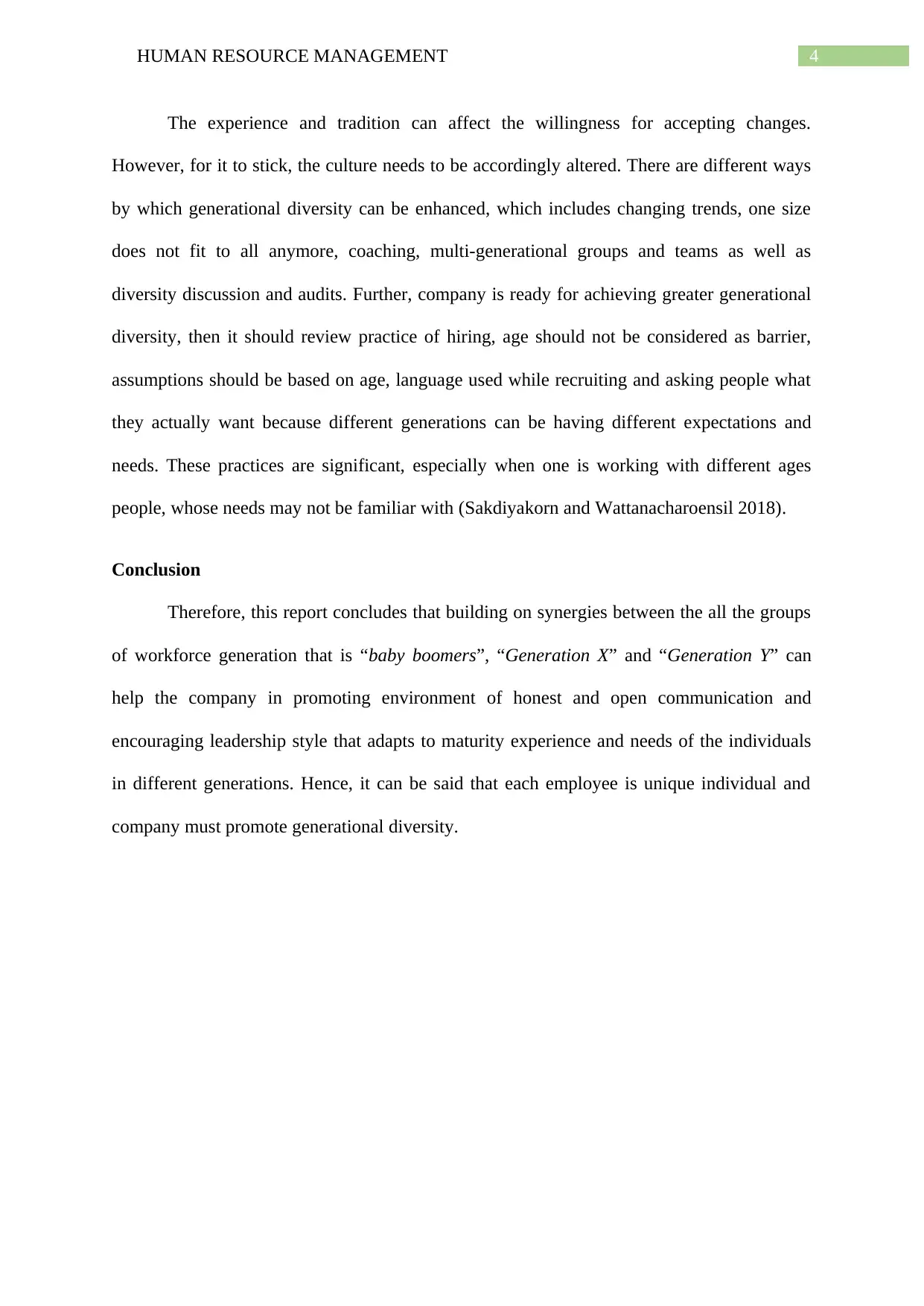
4HUMAN RESOURCE MANAGEMENT
The experience and tradition can affect the willingness for accepting changes.
However, for it to stick, the culture needs to be accordingly altered. There are different ways
by which generational diversity can be enhanced, which includes changing trends, one size
does not fit to all anymore, coaching, multi-generational groups and teams as well as
diversity discussion and audits. Further, company is ready for achieving greater generational
diversity, then it should review practice of hiring, age should not be considered as barrier,
assumptions should be based on age, language used while recruiting and asking people what
they actually want because different generations can be having different expectations and
needs. These practices are significant, especially when one is working with different ages
people, whose needs may not be familiar with (Sakdiyakorn and Wattanacharoensil 2018).
Conclusion
Therefore, this report concludes that building on synergies between the all the groups
of workforce generation that is “baby boomers”, “Generation X” and “Generation Y” can
help the company in promoting environment of honest and open communication and
encouraging leadership style that adapts to maturity experience and needs of the individuals
in different generations. Hence, it can be said that each employee is unique individual and
company must promote generational diversity.
The experience and tradition can affect the willingness for accepting changes.
However, for it to stick, the culture needs to be accordingly altered. There are different ways
by which generational diversity can be enhanced, which includes changing trends, one size
does not fit to all anymore, coaching, multi-generational groups and teams as well as
diversity discussion and audits. Further, company is ready for achieving greater generational
diversity, then it should review practice of hiring, age should not be considered as barrier,
assumptions should be based on age, language used while recruiting and asking people what
they actually want because different generations can be having different expectations and
needs. These practices are significant, especially when one is working with different ages
people, whose needs may not be familiar with (Sakdiyakorn and Wattanacharoensil 2018).
Conclusion
Therefore, this report concludes that building on synergies between the all the groups
of workforce generation that is “baby boomers”, “Generation X” and “Generation Y” can
help the company in promoting environment of honest and open communication and
encouraging leadership style that adapts to maturity experience and needs of the individuals
in different generations. Hence, it can be said that each employee is unique individual and
company must promote generational diversity.
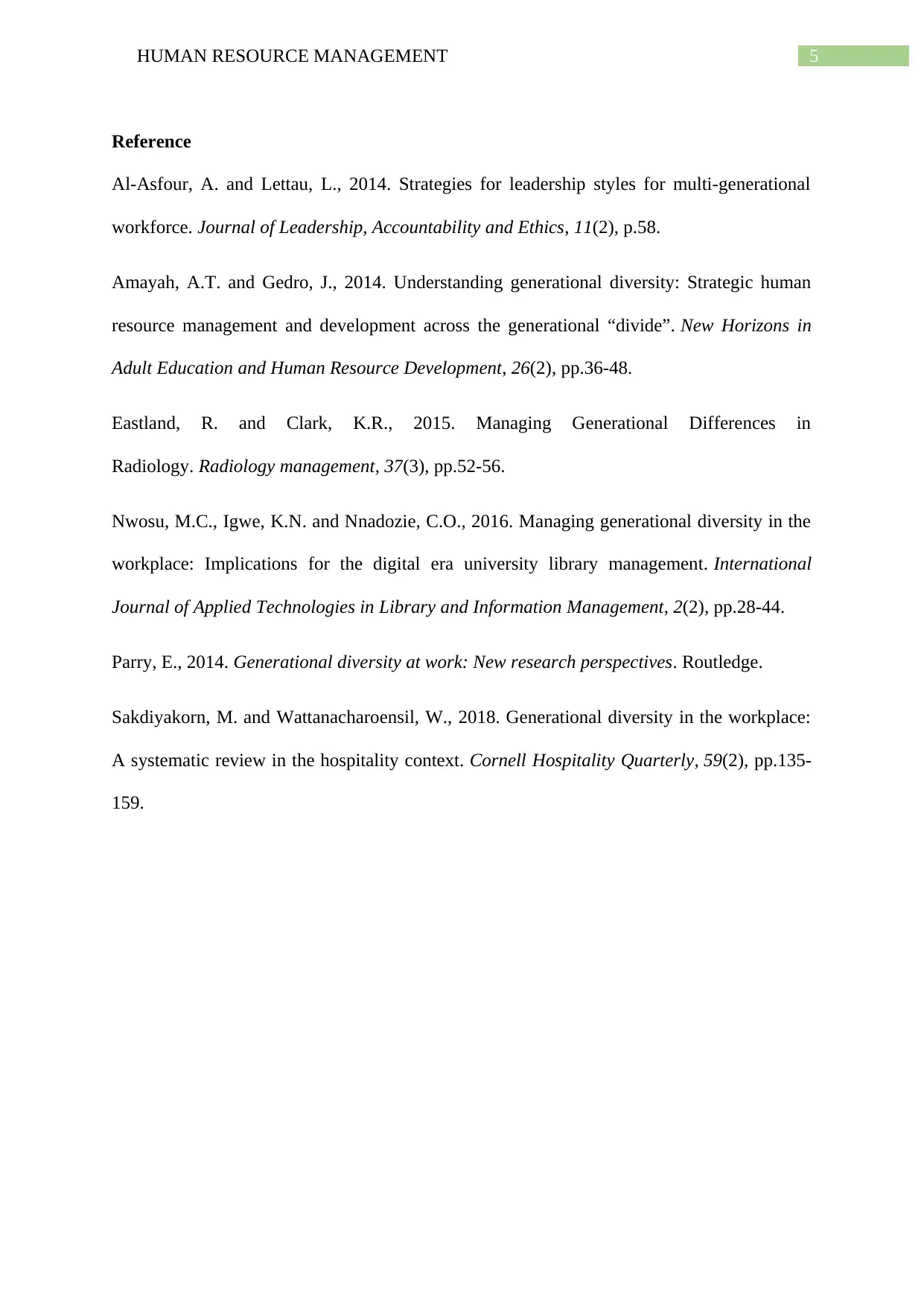
5HUMAN RESOURCE MANAGEMENT
Reference
Al-Asfour, A. and Lettau, L., 2014. Strategies for leadership styles for multi-generational
workforce. Journal of Leadership, Accountability and Ethics, 11(2), p.58.
Amayah, A.T. and Gedro, J., 2014. Understanding generational diversity: Strategic human
resource management and development across the generational “divide”. New Horizons in
Adult Education and Human Resource Development, 26(2), pp.36-48.
Eastland, R. and Clark, K.R., 2015. Managing Generational Differences in
Radiology. Radiology management, 37(3), pp.52-56.
Nwosu, M.C., Igwe, K.N. and Nnadozie, C.O., 2016. Managing generational diversity in the
workplace: Implications for the digital era university library management. International
Journal of Applied Technologies in Library and Information Management, 2(2), pp.28-44.
Parry, E., 2014. Generational diversity at work: New research perspectives. Routledge.
Sakdiyakorn, M. and Wattanacharoensil, W., 2018. Generational diversity in the workplace:
A systematic review in the hospitality context. Cornell Hospitality Quarterly, 59(2), pp.135-
159.
Reference
Al-Asfour, A. and Lettau, L., 2014. Strategies for leadership styles for multi-generational
workforce. Journal of Leadership, Accountability and Ethics, 11(2), p.58.
Amayah, A.T. and Gedro, J., 2014. Understanding generational diversity: Strategic human
resource management and development across the generational “divide”. New Horizons in
Adult Education and Human Resource Development, 26(2), pp.36-48.
Eastland, R. and Clark, K.R., 2015. Managing Generational Differences in
Radiology. Radiology management, 37(3), pp.52-56.
Nwosu, M.C., Igwe, K.N. and Nnadozie, C.O., 2016. Managing generational diversity in the
workplace: Implications for the digital era university library management. International
Journal of Applied Technologies in Library and Information Management, 2(2), pp.28-44.
Parry, E., 2014. Generational diversity at work: New research perspectives. Routledge.
Sakdiyakorn, M. and Wattanacharoensil, W., 2018. Generational diversity in the workplace:
A systematic review in the hospitality context. Cornell Hospitality Quarterly, 59(2), pp.135-
159.
⊘ This is a preview!⊘
Do you want full access?
Subscribe today to unlock all pages.

Trusted by 1+ million students worldwide
1 out of 6
Related Documents
Your All-in-One AI-Powered Toolkit for Academic Success.
+13062052269
info@desklib.com
Available 24*7 on WhatsApp / Email
![[object Object]](/_next/static/media/star-bottom.7253800d.svg)
Unlock your academic potential
Copyright © 2020–2025 A2Z Services. All Rights Reserved. Developed and managed by ZUCOL.




